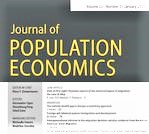A new paper published in the Journal of Population Economics shows that Vietnam’s two-child policy decreased the average number of living children per woman, decreased also the proportion of sons in each family and increased maternal employment.
Read more in:
Effects of Vietnam’s two-child policy on fertility, son preference, and female labor supply
Anh P. Ngo
Journal of Population Economics (2020) 33, Issue 3: 751-794
FREE READ LINK
Author Abstract: In 1988, facing a total fertility rate of over four births per woman, the Vietnamese government introduced a new policy that required parents to have no more than two children. Using data from the Vietnam Population and Housing Censuses from 1989, 1999, and 2009, I apply a differences-in-differences framework to assess the effects of this policy on family size, son preference, and maternal employment. I find that the policy decreased the probability that a woman has more than two children by 15 percentage points for younger women and by 7 percentage points for middle-aged women. The policy reduced the average number of living children by 0.2 births per woman. Low-education women and women in rural areas were more affected by the policy. The policy had no effects on mothers’ age at first birth and gender of mothers’ last birth. The reduction in fertility caused by the policy was associated with a 1.2 percentage point decrease in the proportion of sons in each family. The policy increased maternal employment by 1.3 percentage points. Instrumental variables estimates of the effects of fertility on maternal employment and child education suggest a negative relationship between the number of children and female labor supply and a trade-off between child quantity and child quality in Vietnam.
Access to the newly published complete Volume 33, Issue 3, July 2020.
LEAD ARTICLE OF ISSUE 3:
Blau, F.D., Kahn, L.M., Brummund, P. et al., Is there still son preference in the United States?.
Journal of Population Economics 33, 709–750 (2020). READ LINK FREE.
https://doi.org/10.1007/s00148-019-00760-7

Ends;

